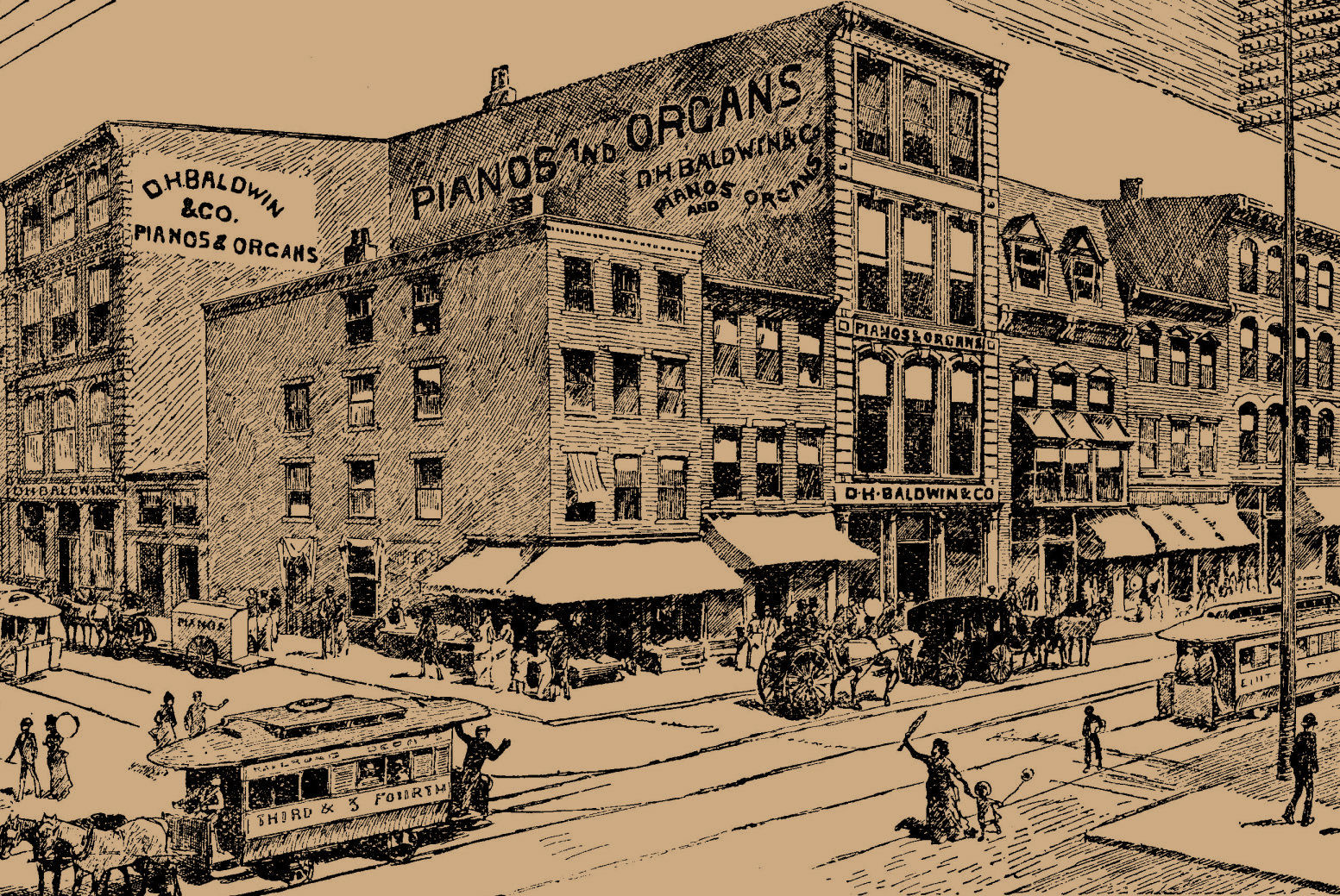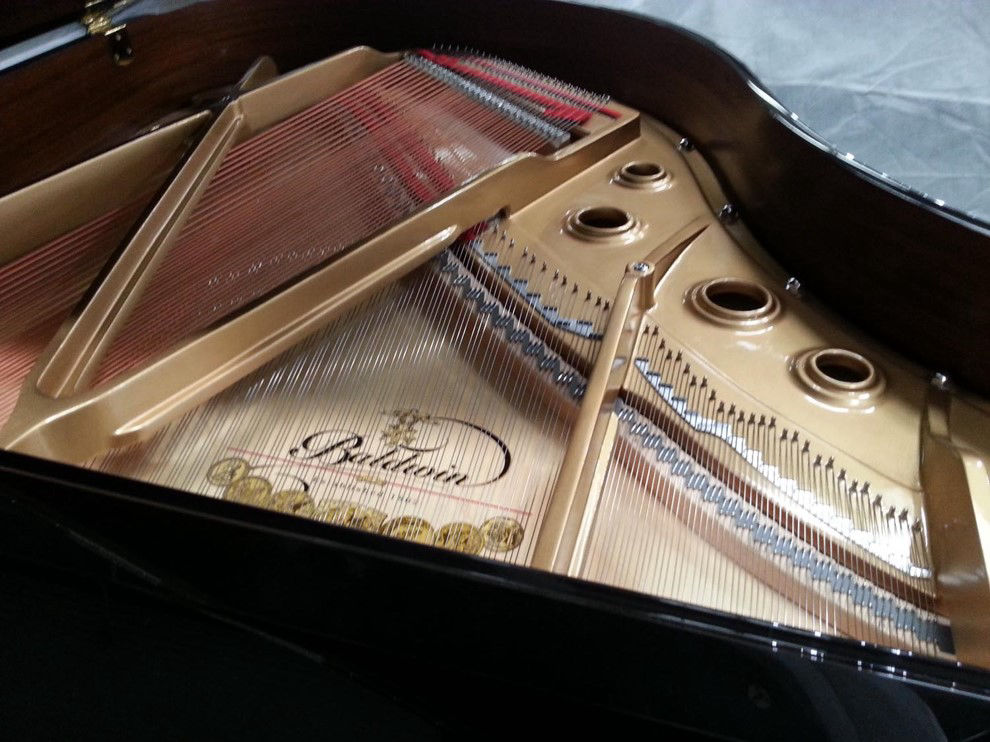

The Baldwin Story
In 1862, reed organ and violin teacher Dwight Hamilton Baldwin opened the doors to his music store in Cincinnati, Ohio. During the next quarter century, Baldwin became one of the largest piano retailers in the Midwestern United States.
With an eye on increased growth opportunities, Baldwin decided to manufacture "the best piano that could be built" in 1890. The first Baldwin piano, an upright model, was available one year later. In 1895, the company introduced its first grand piano, a 5'4" model.
On August 23, 1899, D.H. Baldwin died. Fortunately, one of his strengths had been hiring young men with the potential to lead his company. Lucien Wulsin, who was raised in Alexandria, Kentucky, displayed such promise.
In 1866, Wulsin was a bookeeper for Baldwin. Within seven years, he had become a partner. With a devotion to both business and art, Wulsin helped Baldwin evolve from a successful retail enterprise to a leading builder of pianos.
Baldwin established a worldwide reputation by winning top awards at key expositions. A Baldwin concert grand was honored with the Grand Prix Award at the 1900 International Exhibition in Paris, the first American-made piano to earn the award. It then took top honors in St. Louis (1904) and at London’s Anglo-American Exposition in 1914.
By 1913, Baldwin enjoyed a robust international business, exporting pianos to 32 countries around the globe. Three years later, the company boasted retail divisions in Cincinnati, Chicago, Dallas, Denver, Indianapolis, Louisville, New York, St. Louis and San Francisco.
Baldwin’s artistic coming-of-age was reflected in the many performers who chose the Baldwin grand for concerts and radio broadcasts. Early Baldwin Artists included concert pianists José Iturbi, Wilhelm Bachaus and Walter Gieseking as well as composers Bela Bartok, Ottorino Respighi and Igor Stravinsky.
In addition to traditional pianos, Baldwin manufactured a variety of player piano models, available in both grand and upright styles. This market segement grew quickly, peaking at 56 percent of the industry's total piano production in 1923. Unfortunately, due to new forms of entertainment including the radio, movies, phonographs and automobiles, player sales fell 86 percent by 1929.
Compounding the loss, the Great Depression began in 1929. Baldwin's survival was due to its prudent management. During the early 1920s, Baldwin had created large special reserves for unforeseen needs. These financial resources, along with the direction of Lucien Wulsin II, enabled the company to weather the adversity of this period.
By 1936 the piano industry had rebounded, as consumer purchases in general had risen. The National Piano Manufacturers Association reported that piano sales during the first six months of 1936 were the highest in 15 years.
Baldwin business was interrupted in 1942 when the U.S. War Production Board ordered all piano building stopped due to the war effort. Because of its workworking expertise, Baldwin manufactured wings, fuselage parts and center sections for the Aeronca PT-23 training plane and the Curtiss-Wright C-76 cargo plane, as well as parts for fighter, bomber and glider aircraft.
Lessons learned in the construction of multiple-ply aircraft wings became the basis for Baldwin's 41-ply maple piano pinblock, still in use today for its exceptional tuning stability and strength.
Piano production began soon after the war ended in 1945. A strong post-war economy boosted sales, with Baldwin's 1953 piano production doubling that of its pre-war peak.
In 1965, a revolutionary new Baldwin was introduced. The SD10 Concert Grand was heralded as a major advancement in piano design. A music critic cited in a Time magazine article about the new piano exclaimed, "If Beethoven had had a piano like that, the course of music would have been radically altered."
Artists such as Earl Wild, Dave Brubeck, Michael Feinstein and Bruce Hornsby, as well as organizations such as the Boston, Chicago, Cincinnati and Philadelphia orchestras have performed with and featured the SD10.
Baldwin upright pianos have earned the recommendations of music teachers for many years. Nearly 500,000 Hamilton studio pianos have been sold since its introduction in 1939, and Baldwin pianos are found in schools, churches, and performing venues across the United States. In terms of overall production, Baldwin built its 1 millionth vertical piano in 1973.
In late 2001 Baldwin became part of the Gibson Guitar Company (now Gibson Brands), another historic American musical instrument manufacturer. Then in 2007 the Baldwin Zhongshan Factory was opened in Zhongshan, China giving Baldwin a presence in the largest piano market in the world.
The company’s products today include a full line of upright pianos ranging from the classic Acrosonic Console to the 52” Concert Vertical, and six sizes of grand pianos in the new Baldwin Professional Series. Ask your Baldwin dealer for a demonstration today.
Baldwin Chronology
Dwight Hamilton Baldwin is born in Erie County, Pa.
Baldwin establishes a retail piano and organ business in Cincinnati, Ohio.
Lucien Wulsin, a bookeeper with the company since 1866, enters into a partnership with Dwight Baldwin
Designed by Baldwin piano technician and inventor John Warren Macy, the first Baldwin-built vertical piano is offered at the firm’s Cincinnati store.
Baldwin purchases a brick building on Gilbert Avenue in Cincinnati. This location is subsequently expanded to become the company's manufacturing and corporate headquarters.
The first Baldwin grand piano (scale G, 5'4" in length), designed by John Macy, is introduced.
D.H. Baldwin dies.
A Baldwin grand is awarded the Grand Prix at the Paris Exhibition. As a result, Baldwin joins a very limited group of manufacturers supplying concert grands for performing artists.
Lucien Wulsin becomes the first president of Baldwin.
Baldwin player piano production begins.
Baldwin exports pianos to 32 countries around the globe.
A Baldwin piano earns the grand prize at the Anglo-American Exposition in London.
Player piano market peaks at 56 percent of the industry's total piano production.
Mrs. Calvin Coolidge selects a Baldwin piano for the White House.
Lucien Wulsin II, the son of Lucien Wulsin, is named president of Baldwin.
More than 220 radio stations nationwide prefer the Baldwin piano's tone quality for broadcasting.
The Great Depression results in declined piano production. Only 51,000 instruments are manufactured this year by the entire industry.
Baldwin experiments with the creation of electronic musical tones. This leads to the development of the Baldwin electronic church organ.
Baldwin Acrosonic vertical piano is introduced.
Baldwin Hamilton studio piano is unveiled.
During World War II, Baldwin factories produce military aircraft subassemblies. Lessons learned in the construction of wooden aircraft wings ultimately enhance Baldwin’s laminated pinblock designs.
Composer Aaron Copland becomes a Baldwin Artist.
Pianist Liberace becomes a Baldwin Artist.
The first Baldwin electronic organ is introduced.
President Harry Truman plays a Baldwin piano during the first televised tour of the White House.
Baldwin receives a patent for its 41-Ply Pinblock design, which offers exceptional tuning stability.
Lucien Wulsin III is named president of Baldwin.
Two American space flights are guided by electronic encoders developed in Baldwin research laboratories.
Greenwood, Miss., plant opens to craft cabinets for both pianos and organs.
Baldwin begins production of vertical pianos at Conway, Ark., facility.
The 9-foot Baldwin SD10 Concert Grand is unveiled and heralded as the first major advancement in piano design in decades.
Grand piano production begins at Conway, Ark., plant.
Baldwin initiates key and action production in its Jaurez facilities.
Baldwin receives a patent for its Acu-Just Hitch Pin design, which results in improved tonal resonance.
The Baldwin home electro-piano is introduced.
One millionth Baldwin vertical piano is built.
The New York Stock Exchange opens trading of D.H. Baldwin common shares.
Dick Harrison, who joined the company in 1955 as assistant treasurer, is named president.
The Baldwin FunMachine, a popular easy-to-play electronic keyboard, is introduced.
Production of vertical pianos begins at Baldwin's Trumann, Ark., piano facility.
The Baldwin Model 6000 Concert Vertical piano (52" in height) is unveiled.
Baldwin senior management acquires the Company from Baldwin-United Corporation.
After being privately held by senior management, an initial public stock offering is made. Shares are listed on the NASDAQ National Market. (Symbol: BPAO)
Baldwin purchases the keyboard division of The Wurlitzer Company.
Karen Hendricks, previously with Dial Corp. and The Procter & Gamble Company, succeeds Dick Harrison as Baldwin president and CEO.
The Chickering name is reintroduced to consumers on new grand piano models manufactured by Baldwin.
The Baldwin Pianovelle digital piano product line is introduced.
The Baldwin ConcertMaster Complete Player System, a state-of-the-art player piano system, is introduced at the music products industry’s largest trade show.
The Baldwin ConcertMaster Compact Disc player piano system is introduced, enabling almost any piano to become a high-tech, computerized player piano system.
Baldwin continues to offer America's favorite acoustic pianos, digital pianos and innovative computerized player piano systems.
Baldwin assets purchased by Gibson Guitar Corp. of Nashville, TN. Baldwin headquarters moved to Nashville
Gibson adds Baldwin marketing and product placement to the Gibson Entertainment Relations Division, promoting Baldwin at 18 offices worldwide.
Gibson opens the Baldwin Zhongshan factory in Zhongshan, China dedicated to making Vertical Pianos. Gibson also acquires the Dongbei Musical Instrument factory in Yingkou, China and renames it Baldwin Dongbei.
New models introduced from the Baldwin Zhongshan factory include Acrosonic style Consoles and a new B243 Institutional Studio. A new line of Baldwin Grand Pianos from Baldwin Dongbei features Grand Pianos from 4’6” to 9’ in length.
North American Music is assigned as exclusive USA distributor for Baldwin Pianos. This adds a piano specialty company to market and sell Baldwin Pianos, and retains the promotional strength of the Gibson ER Division and the manufacturing expertise of Baldwin Zhongshan, Baldwin Dongbei, and Baldwin USA.
Baldwin and North American Music introduce the new Baldwin Professional Grand Series. Models BP148, BP152, and BP165 are available.
The new BP190 (6’3”) and BP178 (5’10”) models are introduced at NAMM 2014 including the new Magic-Lid slow close Grand Piano Lid system.
The model BP211 Semi-Concert Grand is introduced, making 6 different size models available in the Baldwin Professional Grand Series.
